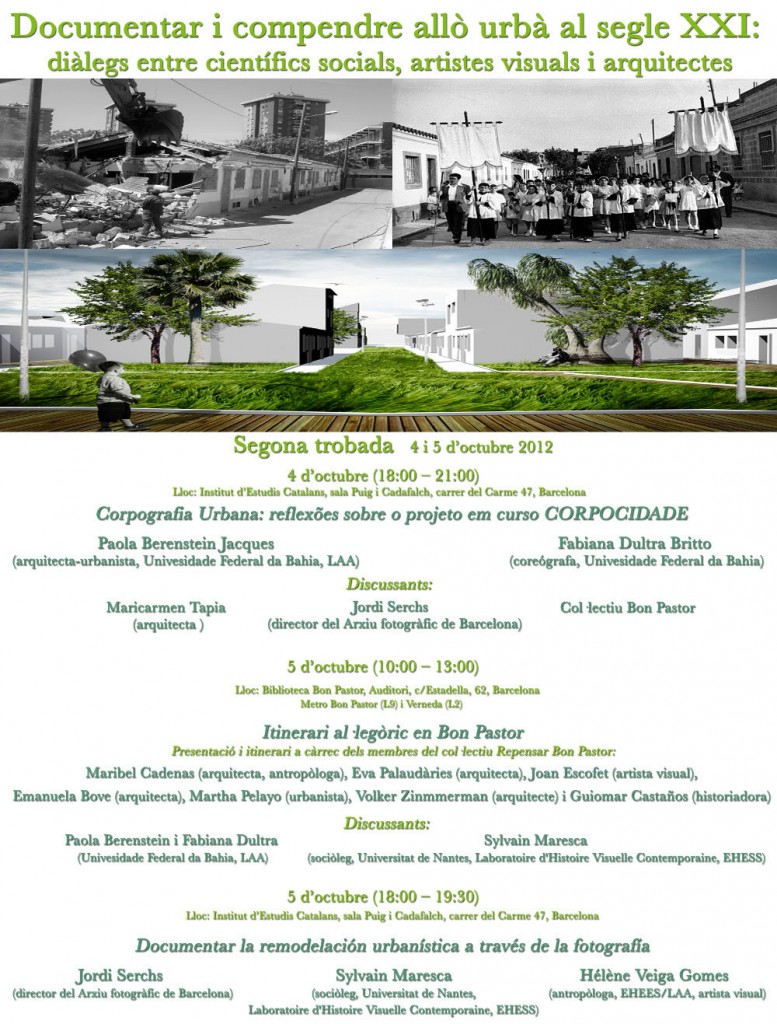
Articles by admin


Shift Happens! Critical Mass at 20
 The Critical Mass is an “organised coincidence" of cyclists that periodically celebrate a collective bike ride in the streets; its purpose is to show to the society the great advantages that bicycles could provide to urban mobility. In the occasion of the 20th anniversary of the first Critical Mass in San Francisco, one of its pioneers, Chris Carlsson, together with other contributors, edited the book Shift Happens. Critical Mass at 20, a collection of experiences and essays from some of the over 300 cities of the world in which the event reached an autonomous life, after that first bicycle ride. This is the meaning of the expression critical mass - the number of participants needed for phenomenon to start moving and growing by itself. The Critical Mass does'nt ask, it builds, giving form to a livable city through its own praxis. The presentation of the book in Madrid - where every last thursday of the month a Bicicrítica is held through the center of the city, while ten more happen in other neighborhoods and municipalities (like Fuenlabrada, Tres Cantos, Alcalá de Henares, Moratalaz, Ciudad Lineal) - was the occasion for a radio debate in "Carne Cruda", RN3, for the participation of the book's editors in a bicicrítica (read here Carlsson's impressions) and for the presentation of another book of his "Nowtopia, How Pirate Programmers, Outlaw Bicyclist and Vacant-Lot Gardeners Are Inventing the Future Today", in Traficantes de Sueños bookshop (here the audio of the event). Shift Happens's chapter on Madrid is the summary of an ethnografic article on bicycle repair workshops inside the occupied social centers of Madrid, that can be downloaded entirely from the link below.
The Critical Mass is an “organised coincidence" of cyclists that periodically celebrate a collective bike ride in the streets; its purpose is to show to the society the great advantages that bicycles could provide to urban mobility. In the occasion of the 20th anniversary of the first Critical Mass in San Francisco, one of its pioneers, Chris Carlsson, together with other contributors, edited the book Shift Happens. Critical Mass at 20, a collection of experiences and essays from some of the over 300 cities of the world in which the event reached an autonomous life, after that first bicycle ride. This is the meaning of the expression critical mass - the number of participants needed for phenomenon to start moving and growing by itself. The Critical Mass does'nt ask, it builds, giving form to a livable city through its own praxis. The presentation of the book in Madrid - where every last thursday of the month a Bicicrítica is held through the center of the city, while ten more happen in other neighborhoods and municipalities (like Fuenlabrada, Tres Cantos, Alcalá de Henares, Moratalaz, Ciudad Lineal) - was the occasion for a radio debate in "Carne Cruda", RN3, for the participation of the book's editors in a bicicrítica (read here Carlsson's impressions) and for the presentation of another book of his "Nowtopia, How Pirate Programmers, Outlaw Bicyclist and Vacant-Lot Gardeners Are Inventing the Future Today", in Traficantes de Sueños bookshop (here the audio of the event). Shift Happens's chapter on Madrid is the summary of an ethnografic article on bicycle repair workshops inside the occupied social centers of Madrid, that can be downloaded entirely from the link below.
- Elisabeth LORENZI (2010) “Centro social en movimiento. Los talleres de auto-reparación de bicicletas en espacios autogestionados” in Mario Domínguez, Miguel Ángel Martínez, Elísabeth Lorenzi, Okupaciones en Movimiento. derivas, estrategias y políticas. Madrid: Tierradenadie [ENLACE]
- Web of Bicios@s collective in Barcelona, and of bicitaller of "edificio 15O"
- web of the Critical Mass in Madrid: Bicicrítica
- The final presentation of "Shift Happens" in a bookshop in San Francisco will be on september 26th, the day of the anniversary, and will be part of a series of activities that will attract to the city cyclists from different places.

Towards a glossary of new urban rhetorics
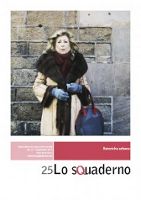 The last number of the review "Lo Squaderno" analyses some of the keywords in the new urban rhetorics: an articulation of the neoliberal newspeak from which Loïc Wacquant and Pierre Bourdieu warned us more than 10 years ago. Expressions like "vibrant city", "common goods", "mixité", "integration", "creativity", and obviously "citizen participation" are recurring terms in the lexicon of urban policies, serving as excuses for conducts contradictory with the original sense of the words that compose them (like we stressed in our work A Barcelona la participación canta). A series of academical and non-academical scholars discuss these rhetorical constructions bringing examples from Naples, Boston, Istanbul, Amsterdam, Vancouver, and, of course, Barcelona. The issue is illustrated with Rosario Kuri's reportage Barcelona bordes irregulares we linked in a previous post. Download Lo Squaderno n.25 here (italian - english).
The last number of the review "Lo Squaderno" analyses some of the keywords in the new urban rhetorics: an articulation of the neoliberal newspeak from which Loïc Wacquant and Pierre Bourdieu warned us more than 10 years ago. Expressions like "vibrant city", "common goods", "mixité", "integration", "creativity", and obviously "citizen participation" are recurring terms in the lexicon of urban policies, serving as excuses for conducts contradictory with the original sense of the words that compose them (like we stressed in our work A Barcelona la participación canta). A series of academical and non-academical scholars discuss these rhetorical constructions bringing examples from Naples, Boston, Istanbul, Amsterdam, Vancouver, and, of course, Barcelona. The issue is illustrated with Rosario Kuri's reportage Barcelona bordes irregulares we linked in a previous post. Download Lo Squaderno n.25 here (italian - english). 
Chinatowns at the center: Gary McDonogh
A brilliant contribution to the story of the material and symbolic construction of the various chinatowns of the world, explained by one of the scholars who better explained the creation of the myth on Barcelona's oldest chinatown: the Raval, a chinese neighborhood without chinese. Seminari iD Barrio - Idensitat, Barcelona, november 28th, 2009, watch video on Vimeo

“Re-cordar” Can Ricart: to pass it back through the heart
Twelve years after the approval of "Plan 22@", two pieces of news show us the long-term impact of the displacement of factories from Poblenou neighborhood, and of its supposed urban renewal. The Mas Candle manifacturer closed in march, exactly five years after being removed from their old location in Can Ricart; in april, four people died in a fire of a shack close to the Jean Nouvel's new Parc Central [link here]. The words of Jaume Pagès, former administration manager of the factory, take us back to the sensations of that old battle we lost but we didn't forget.
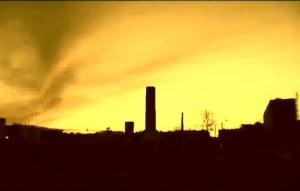 el desahucio
"bueno,
en primer lugar, te sientes echado, no querido, violentado. se rompe de pronto el universo ese repetitivo e invariable y, sin avisar, todo zozobra,
nada parece real.
incluso los cambios en el barrio,
los derribos,
no tienen ninguna connotación positiva, sólo resultaban amenazadores,
tristes.
trasladar una empresa es complicado.
es decir,
debería serlo, pq una empresa, por encima de todo,
la forman personas.
eso quiere decir q se trastorna –de pronto- toda la cosmogonía de tooodos los integrantes...
el desahucio
"bueno,
en primer lugar, te sientes echado, no querido, violentado. se rompe de pronto el universo ese repetitivo e invariable y, sin avisar, todo zozobra,
nada parece real.
incluso los cambios en el barrio,
los derribos,
no tienen ninguna connotación positiva, sólo resultaban amenazadores,
tristes.
trasladar una empresa es complicado.
es decir,
debería serlo, pq una empresa, por encima de todo,
la forman personas.
eso quiere decir q se trastorna –de pronto- toda la cosmogonía de tooodos los integrantes...
 el desahucio
"bueno,
en primer lugar, te sientes echado, no querido, violentado. se rompe de pronto el universo ese repetitivo e invariable y, sin avisar, todo zozobra,
nada parece real.
incluso los cambios en el barrio,
los derribos,
no tienen ninguna connotación positiva, sólo resultaban amenazadores,
tristes.
trasladar una empresa es complicado.
es decir,
debería serlo, pq una empresa, por encima de todo,
la forman personas.
eso quiere decir q se trastorna –de pronto- toda la cosmogonía de tooodos los integrantes...
el desahucio
"bueno,
en primer lugar, te sientes echado, no querido, violentado. se rompe de pronto el universo ese repetitivo e invariable y, sin avisar, todo zozobra,
nada parece real.
incluso los cambios en el barrio,
los derribos,
no tienen ninguna connotación positiva, sólo resultaban amenazadores,
tristes.
trasladar una empresa es complicado.
es decir,
debería serlo, pq una empresa, por encima de todo,
la forman personas.
eso quiere decir q se trastorna –de pronto- toda la cosmogonía de tooodos los integrantes... 
Urban Typhoon: User-generated cities in Mumbai
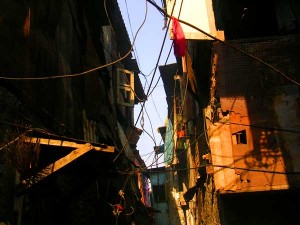 Who is not frightened by the idea of the unstoppable growth of cities in Asia and in the former "third world", or by the perspective (apocalyptical, though critically framed) of moving towards a planet of slums? But in the places closer to this phenomenon - for example in the popular neighborhoods of Mumbai, India - the idea of slum has been criticized since many decades. These urban zones that don't even deserve being called neighborhoods, always presented towards the exterior as marked by lacks (of hygiene, of safety, of integration, of control, even of morality), under a deeper scrutiny reveal histories and dynamics complex and functional, that had been interpreted in various forms according to the different theories. Based in an office in Dharavi-Koliwada (the enormous neighborhood popularized by Slumdog millionaire), the two urban activists Matias ECHANOVE and Rahul SRIVASTAVA (from Urbz collective) show how a series of spontaneous social structures, internal to the so-called slums, cause a constant improvement and development, often obstructed by local authorities or by urban reform plans. In territories as thick and reticular as forests of mangroves, the only valid ways to development are those generated by their very users: homegrown, as the neighborhoods themselves.
Who is not frightened by the idea of the unstoppable growth of cities in Asia and in the former "third world", or by the perspective (apocalyptical, though critically framed) of moving towards a planet of slums? But in the places closer to this phenomenon - for example in the popular neighborhoods of Mumbai, India - the idea of slum has been criticized since many decades. These urban zones that don't even deserve being called neighborhoods, always presented towards the exterior as marked by lacks (of hygiene, of safety, of integration, of control, even of morality), under a deeper scrutiny reveal histories and dynamics complex and functional, that had been interpreted in various forms according to the different theories. Based in an office in Dharavi-Koliwada (the enormous neighborhood popularized by Slumdog millionaire), the two urban activists Matias ECHANOVE and Rahul SRIVASTAVA (from Urbz collective) show how a series of spontaneous social structures, internal to the so-called slums, cause a constant improvement and development, often obstructed by local authorities or by urban reform plans. In territories as thick and reticular as forests of mangroves, the only valid ways to development are those generated by their very users: homegrown, as the neighborhoods themselves. 
Recipes for interculturality from Bilbao
 Arroces del Mundo, Munduko Arrozak, is a popular fiesta being held since 2004 in San Francisco neighborhood, Bilbao (Basque country) . This barrio, apart from the center for the estuary and the railway, is four times more populated than the rest of the city; it has always been stigmatized as a ghetto, related with prostitution, considered a marginal part of the city where the immigrant live, and recently is becoming to be partially gentrified. The fiesta is the result of a patient networking that the Coordinadora de Grupos de Bilbao la Vieja, San Fraencisco y Zabala had been doing for years: this organization was born to influence in the Renewal Plan designed by the City Council, and is made of groups and individuals who had already done projects of social communication in the neighborhood. The idea of the fiesta serves both to denounce the abandon of the neighborhood, and to aim at the construction of intercultural relationships through autonomy and self-organization: the organizers of the event stress that as many people are involved, as less conflicts and incidents ocurr - with the practice, this undermines the securitarian discourse used by the authorities to increase police presence in San Francisco neighborhood.
Arroces del Mundo, Munduko Arrozak, is a popular fiesta being held since 2004 in San Francisco neighborhood, Bilbao (Basque country) . This barrio, apart from the center for the estuary and the railway, is four times more populated than the rest of the city; it has always been stigmatized as a ghetto, related with prostitution, considered a marginal part of the city where the immigrant live, and recently is becoming to be partially gentrified. The fiesta is the result of a patient networking that the Coordinadora de Grupos de Bilbao la Vieja, San Fraencisco y Zabala had been doing for years: this organization was born to influence in the Renewal Plan designed by the City Council, and is made of groups and individuals who had already done projects of social communication in the neighborhood. The idea of the fiesta serves both to denounce the abandon of the neighborhood, and to aim at the construction of intercultural relationships through autonomy and self-organization: the organizers of the event stress that as many people are involved, as less conflicts and incidents ocurr - with the practice, this undermines the securitarian discourse used by the authorities to increase police presence in San Francisco neighborhood. 
Once we made news: the forgotten battles
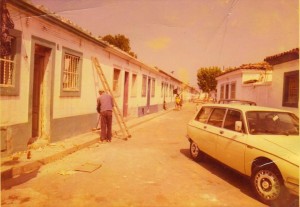 It is been decades now that in Barcelona whole neighborhoods are demolished without the media even mentioning them any more. If someday these situations "made news", soon oblivion covers back their memory. A recent example was Can Tunis neighborhood, whose demolition was surrounded by silence in summer 2004; but in 1993, another neighborhood in the same Zona Franca district, the cases barates of Eduard Aunós fell leaving almost no trace in the city collective memory. The media were too busy celebrating the success of the Olympic Games, as well as years later they were covering the 2004 Universal Forum of Cultures. A group of former inhabitants of Eduard Aunós have found this old reportage: it reminds us a forgotten battle, astonishingly similar to the one now taking place around the demolition of anouther group of cases barates: Bon Pastor. Someday, this one too will be forgotten.
It is been decades now that in Barcelona whole neighborhoods are demolished without the media even mentioning them any more. If someday these situations "made news", soon oblivion covers back their memory. A recent example was Can Tunis neighborhood, whose demolition was surrounded by silence in summer 2004; but in 1993, another neighborhood in the same Zona Franca district, the cases barates of Eduard Aunós fell leaving almost no trace in the city collective memory. The media were too busy celebrating the success of the Olympic Games, as well as years later they were covering the 2004 Universal Forum of Cultures. A group of former inhabitants of Eduard Aunós have found this old reportage: it reminds us a forgotten battle, astonishingly similar to the one now taking place around the demolition of anouther group of cases barates: Bon Pastor. Someday, this one too will be forgotten. 
Suburbs according to Reclús
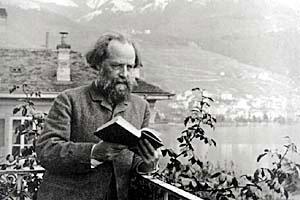 The suburbs, according to the anarchist geographer Elisée Reclús (1830-1905), are not places of exclusion in which are confined those who can't afford to live in the city center. On the contrary, the margins, the periphery, were for him the ideal spaces to develop ways of life closer to nature, without losing the relationship with the hustle and bustle of the city (Reclús had been involved in Paris Commune), but out of the insane density of the metropolis. Reclús lived the last half of his adult life in the suburbs, claiming the last urban fringes as places that permit to break the gap between nature and the city; a central problem for the geographers and urbanists of his time, especially the ecologists and anarchists (Patrick Geddes, Lewis Mumford and, in Catalonia, Cebrià de Montoliu).
The suburbs, according to the anarchist geographer Elisée Reclús (1830-1905), are not places of exclusion in which are confined those who can't afford to live in the city center. On the contrary, the margins, the periphery, were for him the ideal spaces to develop ways of life closer to nature, without losing the relationship with the hustle and bustle of the city (Reclús had been involved in Paris Commune), but out of the insane density of the metropolis. Reclús lived the last half of his adult life in the suburbs, claiming the last urban fringes as places that permit to break the gap between nature and the city; a central problem for the geographers and urbanists of his time, especially the ecologists and anarchists (Patrick Geddes, Lewis Mumford and, in Catalonia, Cebrià de Montoliu). 
International conference on anthropology of urban conflict: call for papers
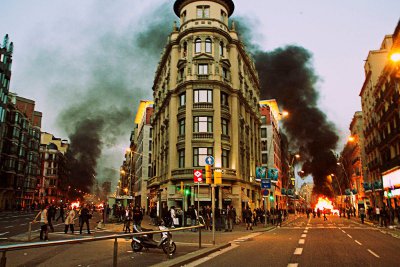 From november 7th to 10th, 2012, in the faculty of geography and history of University of Barcelona, the first International Conference on Anthropology of Urban Conflict will be held, with the title: Desertions, countermovements and forced mobilities in the contemporary city. They had been organized by a series of research groups and individual scholars, and they aim to a critical exposition and reflection on urban phenomena associated to struggles and antagonist movements who take place in the city. In particular, they will focus on the agitations specifical to this moment of crisis, and on the modalities through which they are challenging the public order, the norms that mantain it and the authorities that defend it. A number of international lecturers have already confirmed their assistance: Monica Degen from London, Lia Yoka from Thessaloniki, José Fernandes from Porto, Stavros Stavrides from Athens, or Santiago Cirugeda from Sevilla. Some videos on the struggles in the city are also programmed, as well as a route of the rebel Barcelona. More info and details of the Call for papers on the conference webpage: http://espaiurba.org. For contact write to: conflictesurbans2012@gmail.com.
From november 7th to 10th, 2012, in the faculty of geography and history of University of Barcelona, the first International Conference on Anthropology of Urban Conflict will be held, with the title: Desertions, countermovements and forced mobilities in the contemporary city. They had been organized by a series of research groups and individual scholars, and they aim to a critical exposition and reflection on urban phenomena associated to struggles and antagonist movements who take place in the city. In particular, they will focus on the agitations specifical to this moment of crisis, and on the modalities through which they are challenging the public order, the norms that mantain it and the authorities that defend it. A number of international lecturers have already confirmed their assistance: Monica Degen from London, Lia Yoka from Thessaloniki, José Fernandes from Porto, Stavros Stavrides from Athens, or Santiago Cirugeda from Sevilla. Some videos on the struggles in the city are also programmed, as well as a route of the rebel Barcelona. More info and details of the Call for papers on the conference webpage: http://espaiurba.org. For contact write to: conflictesurbans2012@gmail.com. 
Barcelona, irregular borders
[caption id="attachment_3499" align="alignleft" width="670" caption="Del portfolio "Barcelona bordes irregulares" de Rosario Kuri (2012)."]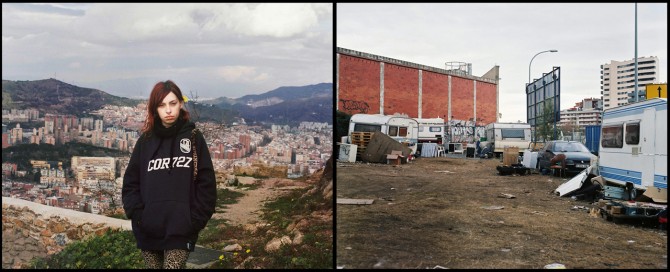 [/caption]
An unordered series of texts, images, webpages, books, reportages, about the differents Barcelonas that we can find between the sea and the mountain, between the Besós and the Llobregat river. Barcelona bordes irregulares [see photos][read text] is a photoreportage by Rosario Kuri (2012) that draws a casual drift for the peripheries, breaking the image of Barcelona's postcards and expressing the diversity of landscapes and people that form the city. La Rabassada o l'utopia de l'oci burgués [webpage] is a book published by Turiscòpia (2012) about the bourgeois casino on the Tibidabo mountain, at the beginning of the XX century. Projecte Icària [webpage][album] is a blog about Poblenou and its industrial heritage, with lots of photos by Marta Domínguez Sensada of the parts of the neighborhood demolished in the 90s . Los intelectuales contra el Raval [post] is a brilliant text by Rodulfo Rufián Roto on the symbolic violence of the mainstream media, in the occasion of the inauguration of Raval's film library. Los jóvenes del barrio, a 1982 video about Canyelles neighborhood (Roquetas), in Youtube. And an article of New Left Review online, "The Spanish model" by Isidro López & Emmanuel Rodríguez [english][spanish], and an essential contribution on the building of the negative myth on the barrio Chino: Chris Ealham (2005) "An imagined geography. Ideology, urban space and protest in the creation of Barcelona's 'Chinatown'", IRSH vol.50, ideal continuation of the famous "Geography of Evil" by Gary MCDONOGH (1987).
[/caption]
An unordered series of texts, images, webpages, books, reportages, about the differents Barcelonas that we can find between the sea and the mountain, between the Besós and the Llobregat river. Barcelona bordes irregulares [see photos][read text] is a photoreportage by Rosario Kuri (2012) that draws a casual drift for the peripheries, breaking the image of Barcelona's postcards and expressing the diversity of landscapes and people that form the city. La Rabassada o l'utopia de l'oci burgués [webpage] is a book published by Turiscòpia (2012) about the bourgeois casino on the Tibidabo mountain, at the beginning of the XX century. Projecte Icària [webpage][album] is a blog about Poblenou and its industrial heritage, with lots of photos by Marta Domínguez Sensada of the parts of the neighborhood demolished in the 90s . Los intelectuales contra el Raval [post] is a brilliant text by Rodulfo Rufián Roto on the symbolic violence of the mainstream media, in the occasion of the inauguration of Raval's film library. Los jóvenes del barrio, a 1982 video about Canyelles neighborhood (Roquetas), in Youtube. And an article of New Left Review online, "The Spanish model" by Isidro López & Emmanuel Rodríguez [english][spanish], and an essential contribution on the building of the negative myth on the barrio Chino: Chris Ealham (2005) "An imagined geography. Ideology, urban space and protest in the creation of Barcelona's 'Chinatown'", IRSH vol.50, ideal continuation of the famous "Geography of Evil" by Gary MCDONOGH (1987).
 [/caption]
An unordered series of texts, images, webpages, books, reportages, about the differents Barcelonas that we can find between the sea and the mountain, between the Besós and the Llobregat river. Barcelona bordes irregulares [see photos][read text] is a photoreportage by Rosario Kuri (2012) that draws a casual drift for the peripheries, breaking the image of Barcelona's postcards and expressing the diversity of landscapes and people that form the city. La Rabassada o l'utopia de l'oci burgués [webpage] is a book published by Turiscòpia (2012) about the bourgeois casino on the Tibidabo mountain, at the beginning of the XX century. Projecte Icària [webpage][album] is a blog about Poblenou and its industrial heritage, with lots of photos by Marta Domínguez Sensada of the parts of the neighborhood demolished in the 90s . Los intelectuales contra el Raval [post] is a brilliant text by Rodulfo Rufián Roto on the symbolic violence of the mainstream media, in the occasion of the inauguration of Raval's film library. Los jóvenes del barrio, a 1982 video about Canyelles neighborhood (Roquetas), in Youtube. And an article of New Left Review online, "The Spanish model" by Isidro López & Emmanuel Rodríguez [english][spanish], and an essential contribution on the building of the negative myth on the barrio Chino: Chris Ealham (2005) "An imagined geography. Ideology, urban space and protest in the creation of Barcelona's 'Chinatown'", IRSH vol.50, ideal continuation of the famous "Geography of Evil" by Gary MCDONOGH (1987).
[/caption]
An unordered series of texts, images, webpages, books, reportages, about the differents Barcelonas that we can find between the sea and the mountain, between the Besós and the Llobregat river. Barcelona bordes irregulares [see photos][read text] is a photoreportage by Rosario Kuri (2012) that draws a casual drift for the peripheries, breaking the image of Barcelona's postcards and expressing the diversity of landscapes and people that form the city. La Rabassada o l'utopia de l'oci burgués [webpage] is a book published by Turiscòpia (2012) about the bourgeois casino on the Tibidabo mountain, at the beginning of the XX century. Projecte Icària [webpage][album] is a blog about Poblenou and its industrial heritage, with lots of photos by Marta Domínguez Sensada of the parts of the neighborhood demolished in the 90s . Los intelectuales contra el Raval [post] is a brilliant text by Rodulfo Rufián Roto on the symbolic violence of the mainstream media, in the occasion of the inauguration of Raval's film library. Los jóvenes del barrio, a 1982 video about Canyelles neighborhood (Roquetas), in Youtube. And an article of New Left Review online, "The Spanish model" by Isidro López & Emmanuel Rodríguez [english][spanish], and an essential contribution on the building of the negative myth on the barrio Chino: Chris Ealham (2005) "An imagined geography. Ideology, urban space and protest in the creation of Barcelona's 'Chinatown'", IRSH vol.50, ideal continuation of the famous "Geography of Evil" by Gary MCDONOGH (1987). 
Words of Women from the Egyptian Revolution
The first chapters of Words of Women from the Egyptian Revolution are online. The independent troupe of Leil-Zahra MORTADA had been updating this series of videos whose trailers we already linked in a previous post.
[caption id="attachment_3505" align="alignleft" width="120" caption="Rasha Azab"] [/caption]
Chapter 1: Rasha Azab. 29 years old, journalist. She had been involved in social movements since 2000. In the west, she explains, they promote an image of egyptian activists as sweet and non violent: this is a strategy to calm down the protests. "No revolution happens for Twitter or Facebook. Revolutions occur when people take the streets, resist, die, sacrify important things".
[/caption]
Chapter 1: Rasha Azab. 29 years old, journalist. She had been involved in social movements since 2000. In the west, she explains, they promote an image of egyptian activists as sweet and non violent: this is a strategy to calm down the protests. "No revolution happens for Twitter or Facebook. Revolutions occur when people take the streets, resist, die, sacrify important things".
 [/caption]
Chapter 1: Rasha Azab. 29 years old, journalist. She had been involved in social movements since 2000. In the west, she explains, they promote an image of egyptian activists as sweet and non violent: this is a strategy to calm down the protests. "No revolution happens for Twitter or Facebook. Revolutions occur when people take the streets, resist, die, sacrify important things".
[/caption]
Chapter 1: Rasha Azab. 29 years old, journalist. She had been involved in social movements since 2000. In the west, she explains, they promote an image of egyptian activists as sweet and non violent: this is a strategy to calm down the protests. "No revolution happens for Twitter or Facebook. Revolutions occur when people take the streets, resist, die, sacrify important things".

Anthropology of the Street, University of Barcelona
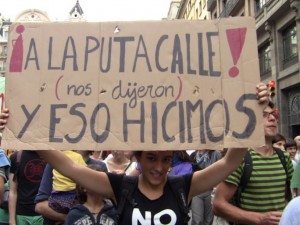 UB, Raval Campus (carrer Montalegre 6, Bcn), Aula 309, 3rd floor. Organization: Institut Català d'Antropologia
April, 12th, 6,30pm-8pm: Alternative parties and the dilemas of tradition (Adrià Pujol, Andres Antebi, Observatori de la vida quotidiana) :: Encounters and inflections between agency and rhetorics in catalan health system (Ariadna Solé, Marta Alonso, Alberto López Bargados, Grup de Recerca Islam de la Diàspora) :: Ethnographic research in Vallcarca neighborhood (Marco Luca Stanchieri, Etnografía dels Espais Públics)
13 abril 2012, 18,30-20h: Urban renewal and social change in la Mina neighborhood (Emanuela Bove, Martha Pelayo, Periferies Urbanes-ICA, download PDF of the research) :: The Rabassada Casino, utopia of the bourgeois leisure time (Sergi Yanes, Turiscòpia-ICA) :: Shanty towns in Barcelona (Mercè Tatjer, Xavi Camino, Oscar Casasayas, Grup d'estudis sobre Barraquisme)
UB, Raval Campus (carrer Montalegre 6, Bcn), Aula 309, 3rd floor. Organization: Institut Català d'Antropologia
April, 12th, 6,30pm-8pm: Alternative parties and the dilemas of tradition (Adrià Pujol, Andres Antebi, Observatori de la vida quotidiana) :: Encounters and inflections between agency and rhetorics in catalan health system (Ariadna Solé, Marta Alonso, Alberto López Bargados, Grup de Recerca Islam de la Diàspora) :: Ethnographic research in Vallcarca neighborhood (Marco Luca Stanchieri, Etnografía dels Espais Públics)
13 abril 2012, 18,30-20h: Urban renewal and social change in la Mina neighborhood (Emanuela Bove, Martha Pelayo, Periferies Urbanes-ICA, download PDF of the research) :: The Rabassada Casino, utopia of the bourgeois leisure time (Sergi Yanes, Turiscòpia-ICA) :: Shanty towns in Barcelona (Mercè Tatjer, Xavi Camino, Oscar Casasayas, Grup d'estudis sobre Barraquisme) 
Madonna dell’Arco
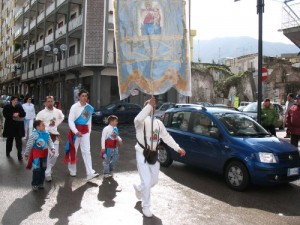 On Eastern Monday, in Sant'Anastasia, Napoli, one of the most interesting processions in Italy takes place, the fujenti gathering in the sanctuary of Madonna dell'Arco. Here's a Here's a short video shot in 2008.
And an audio collage of our recordings inside the sanctuary, also in 2008. [audio:https://periferiesurbanes.org/wp-content/uploads/2012/04/madonna_dell_arco_2008.mp3]
More info: a photoreportage by Mario Spada :: a website about the event, (S.Orsola University, Napols).
On Eastern Monday, in Sant'Anastasia, Napoli, one of the most interesting processions in Italy takes place, the fujenti gathering in the sanctuary of Madonna dell'Arco. Here's a Here's a short video shot in 2008.
And an audio collage of our recordings inside the sanctuary, also in 2008. [audio:https://periferiesurbanes.org/wp-content/uploads/2012/04/madonna_dell_arco_2008.mp3]
More info: a photoreportage by Mario Spada :: a website about the event, (S.Orsola University, Napols). 
Memory of Reclaimed Urban Space in New York
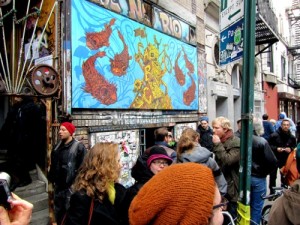 Lower East Side, the small, enigmatic and still resistant neighborhood in Manhattan, (NYC), still keeps the marks of a long history of squatting and counterculture, evidenced by many spaces such as housing projects, social centers and community gardens. The neighborhood is undergoing a strong gentirification process in which squatting has played a special role through recuperation of spaces and local social life. One of these spots provides accomodation for an interesting project of retrieval of the historical live heritage of the neighborhood. MORUS, or Museum of Reclaimed Urban Space, is a small but dynamic museum meant to present squatting and its influence on the neighborhood in an innovatory form, at the same time underlining its live traces. Its promoters intend to show how community and grassroot organizations in East Village helped to transform abandoned buildings and empty lots in spaces for a vibrant community as well as contagious for those who visit it from outside.
Lower East Side, the small, enigmatic and still resistant neighborhood in Manhattan, (NYC), still keeps the marks of a long history of squatting and counterculture, evidenced by many spaces such as housing projects, social centers and community gardens. The neighborhood is undergoing a strong gentirification process in which squatting has played a special role through recuperation of spaces and local social life. One of these spots provides accomodation for an interesting project of retrieval of the historical live heritage of the neighborhood. MORUS, or Museum of Reclaimed Urban Space, is a small but dynamic museum meant to present squatting and its influence on the neighborhood in an innovatory form, at the same time underlining its live traces. Its promoters intend to show how community and grassroot organizations in East Village helped to transform abandoned buildings and empty lots in spaces for a vibrant community as well as contagious for those who visit it from outside. 